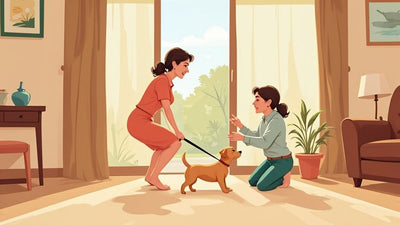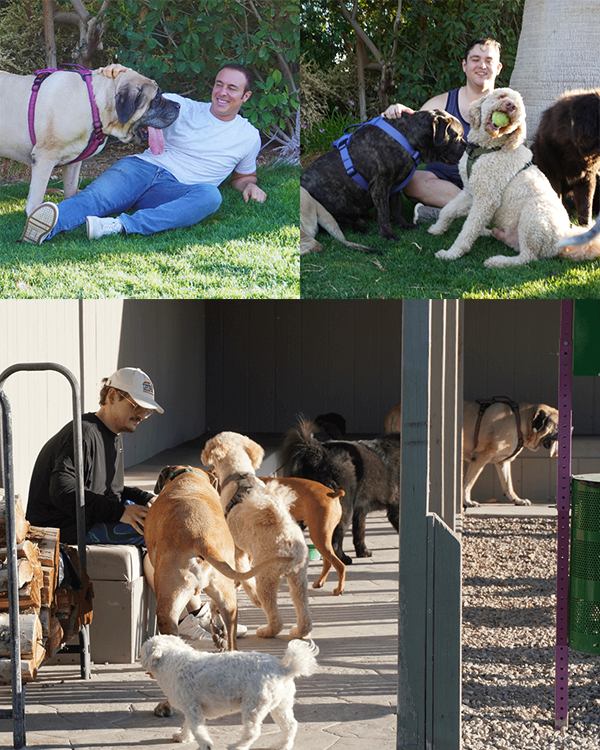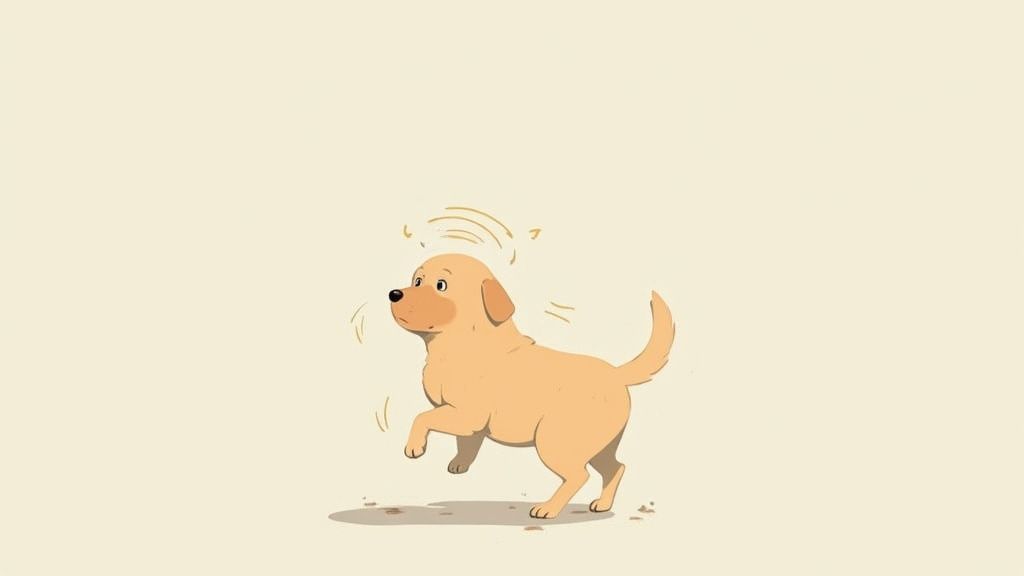
Signs of Neurological Problems in Puppies
Bringing a new puppy home is a whirlwind of joy, full of clumsy tumbles and sleepy snuggles. As you watch them explore their world, it's natural to wonder what's just puppy clumsiness and what might be a sign of something more. We understand that worry. This guide is here to walk with you through the amazing development of your puppy's brain, helping you spot the signs that matter so you can worry less and enjoy this precious time together.
Understanding Your Puppy’s Neurological Journey
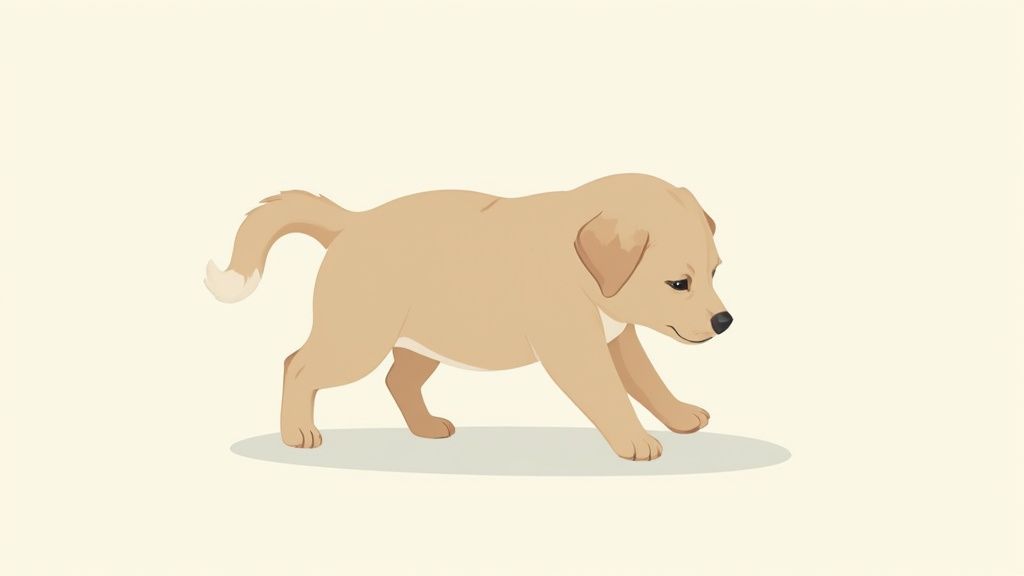
Watching a puppy grow is like witnessing a small miracle. Their nervous system—the command center for everything they do—develops at an incredible pace. Knowing what to expect on this journey can help you feel more confident about every little wobble and twitch, turning worry into wonder.
For the first couple of weeks, a puppy’s world is beautifully simple. They are born with their eyes and ears sealed shut, navigating entirely by touch and smell to find mom for warmth and milk. Their movements are jerky and uncoordinated, and that's exactly how they should be. It’s the start of their amazing journey.
Key Milestones in Their Early Development
As your puppy grows, you’ll see some incredible changes. Think of these as small victories on their path to becoming a healthy, happy dog.
- 2-3 Weeks: Their eyes and ears finally open, connecting them to your world. They'll start responding to light and sound, and you'll see those first heartwarming, wobbly attempts to stand up and walk.
- 3-4 Weeks: You'll see a huge leap in coordination. They begin to play with their littermates, which isn't just adorable—it’s how they build crucial social skills and fine-tune their movements. This is when their unique personality truly begins to shine.
- 4-8 Weeks: Walking turns into confident trotting. Soon they’ll be running and pouncing, exploring their home with a real sense of purpose and curiosity.
Why Are Puppies So Wobbly?
So, why are puppies so clumsy? It's because their brain is busy building the complex pathways needed for smooth, controlled movement. The cerebellum, the part of the brain that supports balance and coordination, is one of the last areas to fully mature. This explains why a young puppy often looks like a little "drunken sailor" as they learn to master their body.
You're not just raising a puppy; you're supporting a rapidly developing neurological system. Every playful stumble is a sign of progress on this amazing journey.
Patience and a safe, supportive environment are everything during this time. For those who want to learn even more about proactive care, our guide to maintaining canine brain health offers deeper insights for every stage of your dog's life. Understanding this foundation helps you celebrate each milestone with confidence.
Get Your FREE Dog Brain Health Guide

Get instant FREE access to today's top ways to help your best friend live a longer, healthier, happier life.
- 39 value-packed pages of expert insights
- Early-detection tips for cognitive decline
- Top brain-boosting superfoods
- Vet-approved mental sharpness strategies
- Fun IQ tests for your dog
Recognizing the Early Warning Signs
When you bring a new puppy home, you spend hours just watching them. Every little pounce and clumsy stumble is adorable. But sometimes, you might notice something that gives you pause. A moment of stillness seems more like confusion. If you've found yourself doing those late-night searches, please know you're not alone. Learning to spot the early warning signs of a neurological issue is the first step toward getting answers and finding peace of mind.
These signs aren't always big or dramatic. More often, they’re subtle shifts in how your puppy moves or responds to the world. Paying close attention to these small changes is one of the most important things you can do. It makes you their best advocate when it's time to talk to your vet.
Seizures and Uncontrolled Movements
A seizure is probably one of the most frightening things a pet parent can witness. While many of us picture a full-body convulsion, seizures in puppies can be much quieter. Sometimes, it’s as subtle as a brief facial twitch, a moment of "zoning out," or even snapping at the air as if they're chasing invisible bugs.
Along the same lines, persistent tremors or shaking when your puppy isn't cold or scared can also be a sign. These kinds of uncontrolled movements suggest there might be a miscommunication happening between their brain and their muscles.
Issues with Balance and Coordination
All puppies are a bit goofy as they learn how their legs work. But there's a difference between playful tumbles and a consistent lack of coordination, which veterinarians call ataxia. This isn’t just tripping over their paws during play; it’s a more constant struggle to walk or stand without losing their balance.
You might notice your puppy:
- Walking with a wobbly, almost "drunken" gait.
- Standing with their legs splayed wide apart just to stay steady.
- Having a hard time navigating around simple things like a rug or chair leg.
This infographic gives a great visual summary of a few key things to watch for, including that wobbly walk (ataxia), circling, and head tilting.
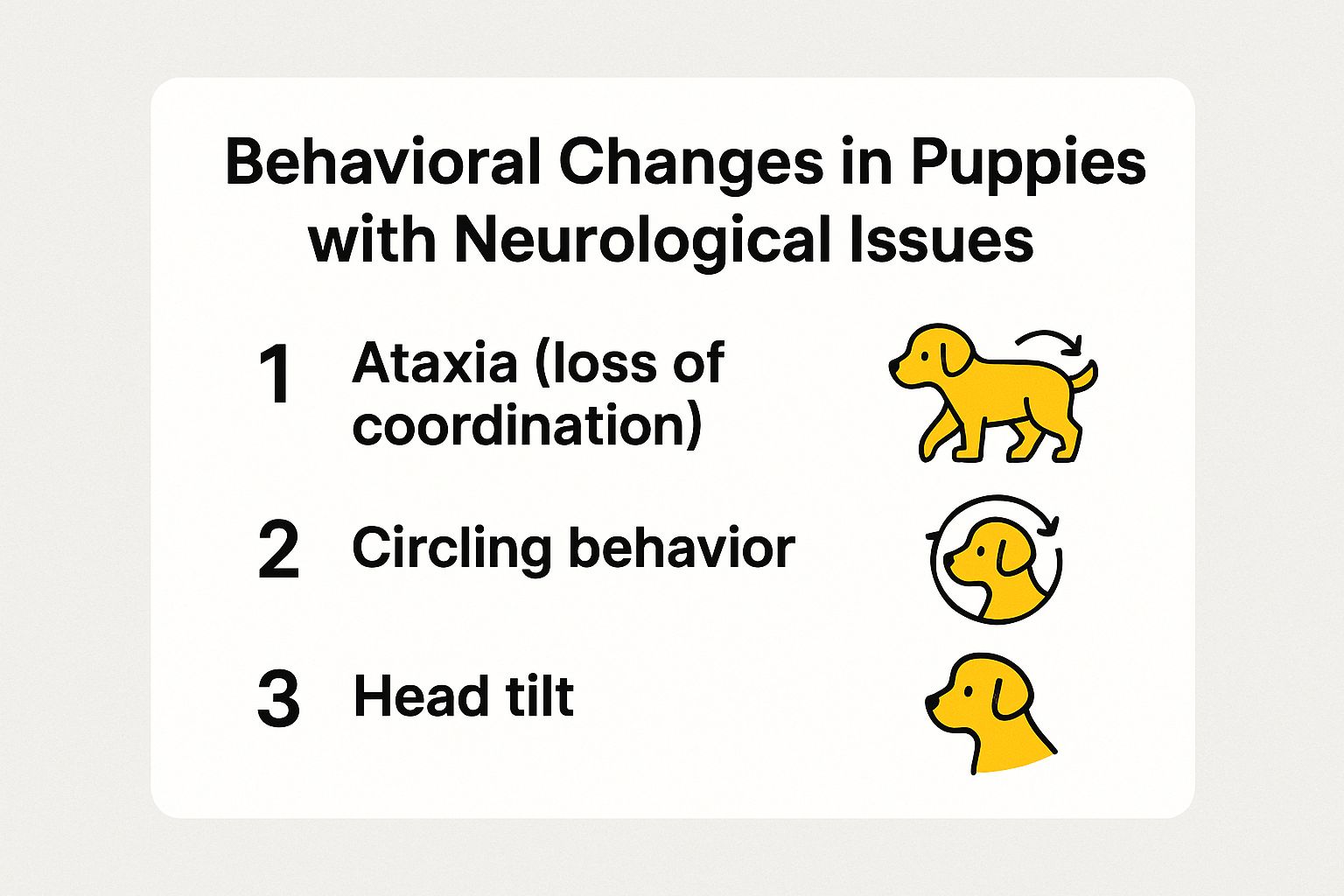
These signs are often clear clues that your puppy's nervous system isn't processing information about their body's position correctly.
Changes in Behavior and Awareness
You know your puppy's personality best. A sudden and unexplained shift in their behavior can be a huge clue. Is your normally curious puppy suddenly seeming lost or confused in your own home? Maybe they’ve stopped responding to their name or have become unusually withdrawn.
Trust your instincts. If you have that gut feeling that your puppy is "just not right"—maybe they seem disoriented or aren't interacting like they used to—that feeling is worth paying attention to. These subtle changes can be very meaningful.
Another behavior that’s a major red flag is head pressing. This is when a puppy compulsively pushes their head against a wall or couch for no clear reason. This often indicates pressure or discomfort inside the head and needs to be checked out by a vet right away.
Unusual Head Posture
A head that is constantly tilted to one side is a classic sign of a neurological issue. This is often linked to the vestibular system, the body's internal GPS for balance. While that cute, curious head tilt they do when you make a funny noise is perfectly normal, a persistent, fixed tilt is not.
You might also see a head tilt paired with nystagmus, which looks like a rapid, involuntary darting of the eyes. These two signs often show up together and point to a problem with your puppy's sense of equilibrium. Pulling out your phone to grab a quick video of these signs can be incredibly helpful for your veterinarian.
To make things a bit easier, here’s a quick summary of what we've covered.
Quick Guide to Common Neurological Signs in Puppies
This table breaks down some common signs, what they actually look like, and what they might mean for your puppy's health.
| Symptom Category | What to Look For | Potential Meaning |
|---|---|---|
| Seizures/Movements | Full convulsions, facial twitching, "fly-snapping," or persistent tremors. | Abnormal electrical activity in the brain or muscle control issues. |
| Balance/Coordination | A wobbly or "drunken" walk (ataxia), wide stance, and frequent stumbling. | The brain, spine, or inner ear isn't communicating properly. |
| Behavior/Awareness | Confusion, getting lost, not responding to their name, or head pressing. | Could indicate cognitive dysfunction, pain, or pressure in the head. |
| Head/Eyes | A constant head tilt to one side or rapid, darting eye movements (nystagmus). | Often points to an issue with the vestibular (balance) system. |
Remember, this is just a guide. Seeing one of these signs isn't a diagnosis, but it is a clear signal that it's time to reach out to your veterinarian for a professional opinion.
Understanding Seizures and Tremors in Puppies
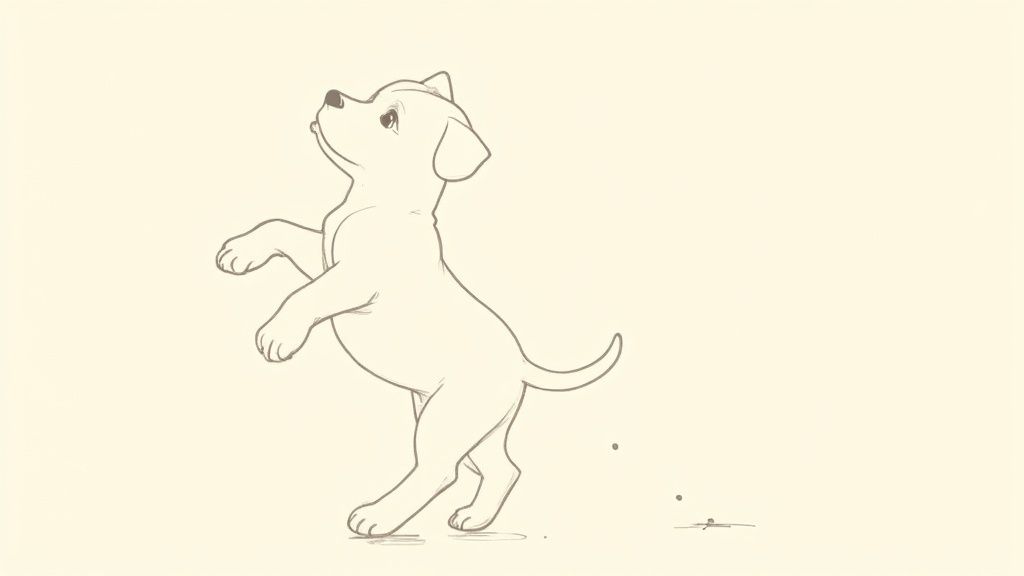
Few things are more frightening than witnessing your puppy have a seizure. In those moments, it’s easy to feel helpless. If this has happened to you, please know that your fear comes from a place of deep love for your little companion. Our goal here is to help you understand what's happening so you can take the next steps with confidence and clarity.
So, what is a seizure? At its core, it’s a sudden, uncontrolled surge of electrical activity in the brain. Think of it as a brief electrical storm that temporarily scrambles the brain's communication lines. It’s one of the most common neurological red flags we see in puppies.
Differentiating Seizure Types
The tricky part is that not all seizures look like dramatic, full-body convulsions. They can be incredibly varied, which is why learning to spot the differences is so important. The more accurately you can describe what happened to your vet, the faster you can get to the root of the problem.
Seizures generally fall into two main categories:
- Generalized Seizures: This is the classic seizure most people think of. The electrical storm affects both sides of the brain at once, typically causing a loss of consciousness, stiffening of the body, and paddling limbs.
- Focal Seizures: These are much subtler because they start in just one small part of the brain. A focal seizure might look like a repetitive facial twitch, constant lip-licking, or even "fly-biting," where a puppy snaps at the air as if catching invisible insects.
It’s incredibly easy to write off a focal seizure as just a funny little quirk. If you can, grab your phone and take a quick video—it can be one of the most helpful tools for your vet's diagnosis.
What About Tremors and Shaking?
You might also notice tremors or uncontrollable shaking, which are different from seizures. While a seizure is a brief, intense event, tremors are more of a persistent, rhythmic muscle movement. This shaking can affect the entire body or just a specific area, like the head or a single leg.
Of course, puppies shiver when they're cold or excited, and that’s perfectly normal. The concern arises when the tremors happen while your puppy is warm, calm, and resting. This can be another clue that the nervous system is misfiring.
Epileptic seizures are a leading cause of these kinds of neurological issues, and they often begin when a dog is young. In fact, research suggests that 0.6% to 1% of all dogs are affected by epilepsy. Canine epilepsy is one of the main reasons puppies experience recurrent seizures, which is understandably a major worry for pet owners. You can learn more about the prevalence of canine epilepsy from recent research.
Watching your puppy go through this is heartbreaking. But your careful observation is the first and most critical step. By understanding what to look for, you become your puppy's most important advocate, ready to partner with your vet to find answers.
What Is Ataxia in Puppies?
Watching a puppy stumble around as they learn to master their own legs is one of the cutest things in the world. But there’s a point where that adorable clumsiness can start to feel like a real concern. If your pup’s tumbles seem less about playful exploration and more like a constant struggle, you might be seeing signs of ataxia.
That’s the clinical term for a loss of coordination, and it’s a major sign of neurological issues in puppies.
Ataxia isn't just about tripping over their paws. It’s a persistent lack of balance that originates in the nervous system. Think of it as a bad connection between your puppy's brain and their body—the brain isn't getting the right signals about where their legs are. This leads to that wobbly, unsteady gait that often looks like a "drunken" walk. You might also notice them standing with their legs unusually far apart just to stay upright.
The Three Main Types of Ataxia
To get a better handle on what you're observing, it helps to know that vets usually categorize ataxia based on which part of the nervous system is having trouble. Each type looks a little different.
-
Cerebellar Ataxia: This type comes from an issue in the cerebellum, the brain's coordination command center. A puppy with cerebellar ataxia often has really exaggerated, high-stepping movements. You might also see "intention tremors"—shaking that gets worse when they try to do something specific, like leaning down to their food bowl.
-
Vestibular Ataxia: The problem here lies with the inner ear and brainstem, the parts responsible for balance. The telltale signs are a persistent head tilt and stumbling. We dive deeper into this in our article on vestibular issues in dogs, which, while common in seniors, can absolutely affect younger dogs too.
-
Sensory Ataxia: This happens when the signals from the spinal cord to the brain get scrambled. These pups often seem completely unaware of where their feet are. They might drag their paws or stand with their legs awkwardly crossed.
Watching your puppy's movements with a bit of understanding is a powerful first step. Simply noting how they're wobbly—is it their head? Their steps? Their whole body?—can give your veterinarian crucial clues.
Ataxia is a hallmark sign of several inherited neurological disorders. For instance, some breeds, like Standard Poodles, can be affected by a condition called neonatal encephalopathy. Puppies with this condition often start showing ataxia and tremors at just three weeks old. As the condition progresses, the weakness worsens, which shows how important those early coordination problems are as a clue. You can read more in this study on inherited neurological diseases.
Our goal isn't to scare you, but to replace that worry with clarity. Knowing the difference between a puppy finding their feet and a puppy with a consistent coordination problem empowers you to be their very best advocate.

Support Your Dog's Brain Health with NeuroChew™
As mentioned in this article, NeuroChew is the first dog chew designed to support both cognitive function and healthy circulation. Perfect for dogs showing early signs of cognitive decline or for proactive brain health support.
Behavioral Clues and Changes in Awareness
You know your puppy better than anyone. You're the first to notice when their personality shifts, even slightly. The signs of a neurological issue aren't always dramatic; sometimes, they're much quieter.
These clues often show up as subtle changes in their behavior and how they interact with the world. One day, your sharp, curious pup might seem lost in your own living room. Maybe they just stand there, confused, or stop responding when you call their name. If your gut tells you something is off, please listen to it.
From Personality Shifts to Disorientation
A sudden change in temperament can be a huge red flag. If your once-cuddly puppy suddenly becomes withdrawn or anxious, it's more than just a bad mood. It can be a sign that something is wrong on a deeper level.
These behavioral shifts are often the first outward sign of an underlying neurological condition. They typically fall into a few key areas:
- Disorientation: Does your puppy seem lost? Maybe they get stuck in corners, can't figure out how to get around the coffee table, or just stare blankly at a wall.
- Reduced Interaction: They might lose interest in their favorite toys, stop seeking you out for cuddles, or seem indifferent to other pets in the house.
- Unresponsiveness: You might find yourself calling their name several times before they even flick an ear in your direction.
It's heartbreaking to see that spark of recognition fade, even for a moment. Please know that you are not overreacting by being concerned about these subtle changes.
We usually think of cognitive decline as a problem for senior dogs. For instance, Canine Cognitive Dysfunction (CCD), which is similar to Alzheimer's in humans, affects between 14% and 35% of the general dog population. Learning about conditions like CCD helps us understand how neurological health impacts behavior at any age. You can read more about canine cognition on the Morris Animal Foundation website.
Noticing these behaviors is the first and most important step. When you see something, make a note of it. What happened? When did it happen? Your observations are gold for your veterinarian. If you're dealing with these kinds of changes, our guide to understanding canine anxiety and behavior can provide more context and support.
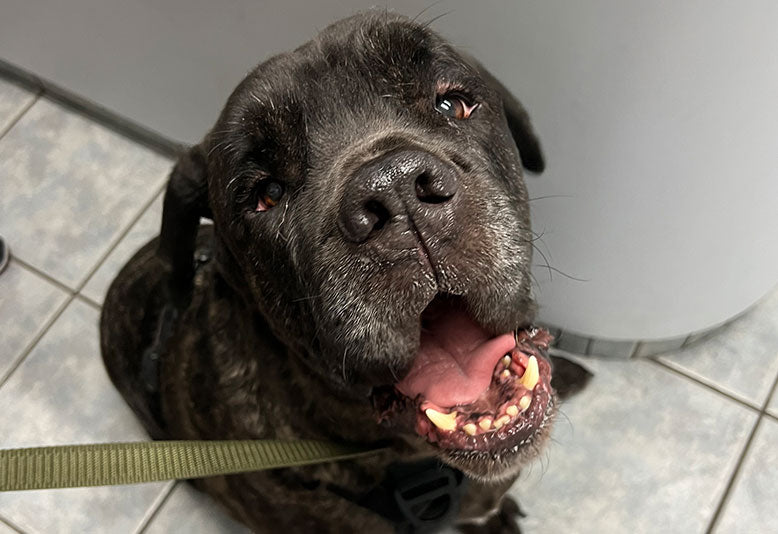
Real Results: How NeuroChew Helped Brutus Regain His Mental Clarity
Brutus was getting disoriented at night. After starting NeuroChew, he's more happy during the day and steady at night. He's back to his old self!
Partnering with Your Veterinarian for Answers
That feeling in the pit of your stomach when you know something isn't right with your puppy can be overwhelming. We get it. The best thing you can do with that worry is turn it into action. Your first and most important step is getting your veterinarian involved.
You live with your puppy day in and day out. You're their number one advocate, and the small things you notice are often the biggest clues.
How to Prepare for the Vet Visit
Spending a little time getting organized before you go can make the appointment so much more effective. When you're stressed, it's easy for details to get jumbled. Coming in with clear notes helps your vet see the full picture.
A bit of prep transforms your observations into the critical information your vet needs.
- Take Videos: This is, hands down, the most helpful thing you can do. Seizures or wobbliness can be hard to describe accurately. A quick video on your phone shows the vet exactly what you’re seeing at home.
- Keep a Log: Grab a notebook to track what's happening. When did you first notice the signs? How often do they occur? Do they happen at certain times, like after a meal? Every detail helps.
- List Your Questions: Your mind will likely go blank in the exam room. Before you go, write down every single question that's been running through your head, no matter how small it seems.
Trust your gut. You know your puppy better than anyone else. If you feel that something is off, that instinct is worth listening to and investigating with a professional.
Think of this as a team effort. By coming to the appointment prepared, you're not just a worried owner; you're an active, empowered partner in your puppy's healthcare. Reaching out for professional help is the most loving thing you can do for your little one.
Common Questions About Puppy Neurological Health

When something seems off with your puppy, your mind can race with questions. That's a completely normal part of being a loving pet parent. Let's walk through some of the most common questions we hear, hopefully bringing a bit of clarity to a stressful time.
Remember, asking questions is the first and most important step. You're your puppy's best advocate.
Can a Puppy Recover From Neurological Problems?
This is usually the first question on every owner's mind, and the honest answer is: it depends entirely on the cause. The good news is that a puppy's brain and nervous system have an incredible capacity for healing, especially when they're young.
Conditions caused by certain infections or toxins often have a good outlook if caught and addressed quickly. On the other hand, congenital or inherited issues might be more about long-term management and support. The goal shifts to ensuring a wonderful quality of life.
Early diagnosis is everything. Working closely with your veterinarian to map out a support plan gives your puppy the best possible path forward.
Every puppy's journey is unique, but there is always hope for providing comfort and more good days together. Focusing on small wins and progress is what truly matters.
What Tests Will a Vet Run for Neurological Signs?
Your veterinarian's investigation will start with a hands-on physical and neurological exam. They'll check reflexes and watch your puppy's gait to find clues about how the nervous system is functioning.
From there, they might suggest a few next steps to dig deeper:
- Blood tests: This is often the first step to check for metabolic problems, toxins, or signs of infection that could be affecting the brain.
- Advanced imaging: An MRI or CT scan gives your vet a direct look at the brain and spinal cord, which is invaluable for spotting structural issues.
- Cerebrospinal fluid (CSF) tap: This test involves taking a small sample of the fluid around the brain and spinal cord, which is excellent for diagnosing inflammation or infections.
Your vet will walk you through why each test is being recommended based on your puppy's specific symptoms.
Are Certain Breeds More Prone to Neurological Issues?
Yes, genetics can play a role. Some breeds are predisposed to certain conditions. For instance, Cavalier King Charles Spaniels are known for a condition called Syringomyelia, and certain terrier breeds can be susceptible to congenital vestibular disease (the "wobbles").
But here’s the key takeaway: a neurological problem can affect any puppy, regardless of breed or mix. Knowing your breed’s potential health risks is simply a tool that helps you stay vigilant and informed on your journey together.
At Furever Active, we believe in supporting your dog's brain health at every stage of life. NeuroChew™ is designed to help maintain cognitive function and promote mental clarity for dogs of all ages. Explore how we can support your journey together at https://fureveractive.com.
Share This Article

Support Your Dog's Brain Health with NeuroChew™
The first dog chew that supports both brain function and healthy circulation. Perfect for dogs of all ages.
- Enhances cognitive function & mental clarity
- Reduces anxiety without sedation
- Supports healthy blood circulation
- Made in USA with natural ingredients
60-Day Money-Back Guarantee • Free Shipping





